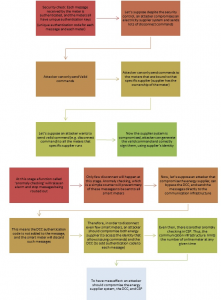In the drive to decarbonise heat in the UK, extensive engineering research and development is being carried out on the technology and infrastructure to allow us to utilise hydrogen as a replacement for natural gas. But it isn’t only a technological challenge. How will society react to this change? What are their thoughts? CESI researchers Dr. Gareth Powells, Lecturer in Human Geography, and Matthew Scott, PhD student and teaching assistant are investigating this. Matthew writes here on the results of their initial surveys.
About the Author

Matthew Scott is Teaching Assistant and PhD Researcher in the School of Geography, Politics and Sociology at Newcastle University.
Contact:- matthew.scott@newcastle.ac.uk
Midway through Jules Verne’s 1874 novel The Mysterious Island, when the protagonists are musing about the ever-increasing burning of coal by Western civilisations, the railway engineer Cyrus Harding abruptly proposes water as the most obvious future energy source. “Water!” exclaims one of his companions, “water as fuel for steamers and engines! water to heat water!” “Yes, my friends,” Harding replies, “I believe that water will one day be employed as fuel, that hydrogen and oxygen which constitute it, used singly or together, will furnish an inexhaustible source of heat and light, of an intensity of which coal is not capable.”

“I should like to see that,” replies Harding’s companion, presumably with more than a hint of incredulity. Although the scepticism of Harding’s companion was probably well placed in 1874, the possibilities of using water – and more specifically hydrogen – as an energy source is now the subject of research being carried out by members of CESI at Newcastle University – Dr. Gareth Powells, Lecturer in Human Geography, and myself, Matthew Scott, a PhD student working as an RA on the project.
Researchers and energy systems stakeholders increasingly believe that hydrogen may have an important role to play in any future shift to a low-carbon economy. Unlike its cousin natural gas, which releases carbon dioxide into the atmosphere when burned, burning hydrogen releases only water into the atmosphere. And while there are still considerable technological uncertainties surrounding how a transition to hydrogen energy might be achieved, several initiatives in the UK are now exploring it more detail; Aberdeen’s hydrogen bus project and Leeds’ H21 Citygate Project being two of the most recent demonstration examples.
However, a great deal hinges on whether or not hydrogen can become an accepted and uncontroversial part of the general public’s everyday energy use. We currently do not know much about how families, communities, and businesses will respond the prospect of using hydrogen in their everyday lives. Furthermore, much depends on how the introduction of hydrogen might transform the way we all go about our core practices of cooking our food, heating our homes, and travelling on the road.
These are the issues that this research is seeking to investigate. Over the summer of 2017 we asked members of the public at different locations in the North East of England what they think about hydrogen, and how they thought using hydrogen might change their everyday lives. We were interested, firstly, in what (if any) existing knowledge people had about hydrogen and its potential use as an energy carrier. This was not only a case of asking about peoples’ knowledge of hydrogen’s properties as a gas, but also about what people associate with hydrogen more generally – if hydrogen is associated with danger, or fire, then this will undoubtedly have implications on the extent to which it can be accepted in the home, regardless of how safe it might be proven to be.
We also asked about whether or not people thought using hydrogen would change the way they cooked and heated their homes, and how it would impact upon their methods of personal transport. As well as emitting no greenhouse gasses when burned, hydrogen also emits no carbon monoxide, and burns with a flame that is almost invisible in daylight conditions. Many of our participants did not know this before speaking to us. We consequently asked participants to imaginatively place themselves in their homes: cooking, turning on the heating, running a bath, and posed – if you were doing all of this using hydrogen, how do you think you would do them differently? And just as importantly, would any change in how you do these things be acceptable to you, or would they be an insurmountable obstacle and therefore push you away from potentially using hydrogen in the future?
As well as this, we sought to explore what worries and fears people might have about using hydrogen, and how this compared to concerns they had about their existing sources of energy like electricity and natural gas. Finally, we also sought to determine, given most people’s knowledge of hydrogen was low, what forms of evidence and information would be valued knowledge about and confidence in hydrogen, and who the public would trust to provide them with it.
The day when hydrogen replaces natural gas in our pipes and boilers might be some time away yet, but Cyrus Harding may have been eerily prescient when, back in 1874, he referred to hydrogen as “the coal of the future.” Yet hydrogen can only be implemented effectively if we appreciate and understand the complex ways it would change our everyday lives and the extent to which any potential changes could weave themselves into our daily practices. As a result, we hope that this research will produce insights of relevance to researchers, industry, and governmental organisations investigating the ways in which hydrogen might be used in the UK energy system.

